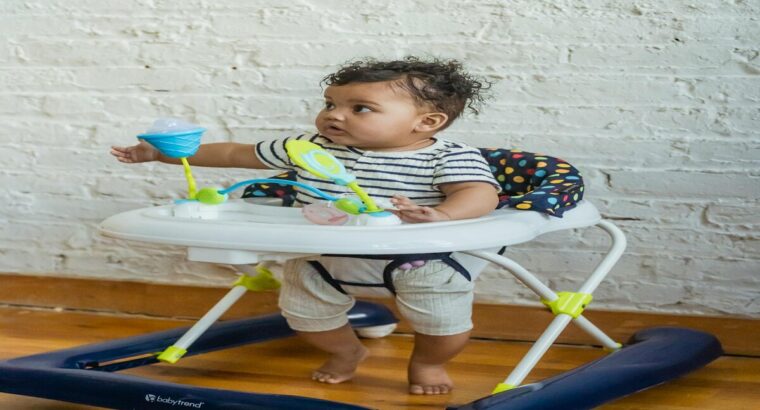Essential Safety Tips for Using Baby Walkers Indoors

Baby walkers are one of those baby items that can instantly light up your little one’s face. Seeing your baby zoom around the house (or at least wobble joyfully) brings a whole new kind of excitement. But as fun as they are, safety is important, especially when your baby is rolling about indoors.
If you’re a first-time parent in Ireland or just looking for ways to baby-proof your space, this blog is for you. We’ll walk you through simple, practical tips that’ll make using baby walkers in Ireland families love a much safer experience.

Why Indoor Safety is Important for Baby Walkers
Babies are fast learners, and once they figure out how to use a walker, they’re ready to explore every nook and cranny. And while walkers can help with motor skills and provide a bit of independent fun, they also come with risks if not used properly.
From tumbling down stairs to bumping into furniture, accidents can happen in a flash. That’s why making your home walker-friendly is so important and totally doable with a few easy changes.
Start With the Right Walker
Before anything else, it all starts with choosing the right walker. Not all walkers are created equal, and you want something that balances fun with safety.
When shopping for baby walkers in Ireland, keep an eye out for:
- A wide and sturdy base to prevent tipping
- Adjustable height so your baby stands properly
- Brake pads or resistance wheels to keep things under control
- Designs that meet European safety standards
Tip: Try to avoid walkers with too many bells and whistles that could overstimulate your baby, sometimes simpler is better.
1. Baby-Proof the Zones They’ll Roll Into
The second your baby starts using the walker, everything in your home becomes fair game. This means it’s time to level up your baby-proofing game.
Watch out for these common home hazards:
- Exposed electrical outlets
- Low-hanging tablecloths or cords
- Sharp furniture edges
- Loose small objects (like coins or crumbs, babies will find them)
- Breakable décor at baby height
Do a floor-level scan of each room. If it looks fun to grab, push, or chew, move it.
2. Use Safety Gates
If you live in a multi-story house or have open-plan areas, safety gates are a must.
Use them to:
- Block access to stairs (up or down)
- Close off kitchens, bathrooms, or anywhere your baby doesn’t need to explore
- Separate pets from walker time
There are loads of easy-to-install pressure-mounted gates available in Ireland that don’t need drilling and are sturdy enough to keep your little explorer safe.
3. Choose Smooth, Non-Slip Floors
Walkers glide best on smooth floors, but that can also mean more speed than you’d like. Slippery surfaces can make your baby zip around faster than expected, so the flooring in your home matters.
Here’s what helps:
- Add non-slip rugs in hallways or slippery areas
- Avoid using the walker on uneven flooring
- Make sure toys, mats, or furniture don’t create trip zones
Even in small apartments or homes, creating one clear, safe area for walker time makes a huge difference.
4. Always Keep an Eye Out
This one might seem obvious, but it’s so important: never leave your baby in a walker unsupervised. They might look sturdy and stable, but babies are surprisingly creative when it comes to getting into trouble.
Best practices:
- Stay in the same room
- Keep walker sessions short (around 15–20 minutes at a time)
- Use walker time as a shared activity, not a break for chores
Think of it more as a playtime session, something you do together to explore and laugh, not just a way to keep your baby busy while you’re cooking.
5. Keep an Eye on Development
As your baby gets stronger and more confident, they’ll eventually outgrow the walker. You’ll start noticing signs like:
- Trying to stand up without help
- Pushing furniture to walk
- Climbing out of the walker
At this stage, swap the walker for more hands-on development toys like push carts, soft furniture for support, or supervised crawling time. All great for boosting those walking muscles.
Let’s Debunk a Few Myths
- “Walkers help babies learn to walk faster.”: Not really. They can build some leg strength, but babies still need floor time, tummy time, and standing support to develop walking skills properly.
- “My house is small, so I don’t need to baby-proof.”: Even in small spaces, a curious baby can get into trouble fast. One room of safety is better than none.
- “The walker has safety features, so I’m good.”: Safety features are helpful, but they don’t replace your supervision or a walker-safe environment.
Conclusion: Safety First, Always

Walkers can be a fun addition to your baby gear, when used with care and within a safe space. From covering up home hazards, setting up safety gates, and laying down non-slip surfaces, a little prep goes a long way.
Looking to get your hands on safe and trusted baby walkers in Ireland? Check out Baby Deals Ireland, we offer a handpicked range of baby walkers designed with comfort, fun, and safety in mind. Whether you’re prepping for your first baby or shopping for a gift, you’ll find baby gear parents actually love and use.Browse our baby walker selection today and roll into safer playtime with confidence.
